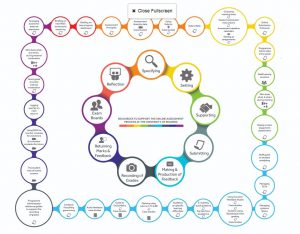Dr Robert Hosfield, School of Archaeology, Geography and Environmental Science
r.hosfield@reading.ac.uk
Year of activity: 2015/16

Lykethos
Overview
The project tested different methods for producing and disseminating 3D models of existing artefacts in the teaching collections of Classics and Archaeology. 3D scanning was labour intensive and struggled to accurately represent some of the raw materials. By contrast photogrammetry was more cost and time effective and produced better quality results (see attached figure). Sketchfab was an effective, user-friendly platform for disseminating the models (https://sketchfab.com/uremuseum), and student feedback was positive.
Objectives
- Produce and evaluate 3D laser scans of 10 lithic artefacts and 5 ceramic artefacts from the teaching collections of Classics and Archaeology, with analysis of 3D model resolution, cost, and time requirements, and dissemination options;
- Document student evaluations of the new resources.
Context
Archaeology and Classics have wide ranging teaching collections of objects, both genuine and replica, from the human past (e.g. Greek and Roman ceramics). While students have access to this material in practical classes and seminars, out-of-class access is more difficult, due to (i) the intensive use of the teaching spaces holding the collections, and (ii) the fragility of selected specimens. The project explored methods that could enable students to engage with this material evidence through digital models.
Implementation
The project was primarily undertaken by four Reading students, both postgraduate and undergraduate: Rosie-May Howard (Bsc Archaeology, Part 2), Matthew Abel (BA Museum Studies & Archaeology, Part 1), Daniel O’Brien (BA Ancient History & Archaeology, Part 3), and James Lloyd (Classics, PGR). Supervision and support was provided by Prof. Amy Smith (Classics), Dr Rob Hosfield (Archaeology) and Dr Stuart Black (Archaeology). The four students undertook the following tasks:
(i) Testing the URE Museum’s NextengineTM HD 3D scanner and associated processing software ScanStudioTM to produce 3D laser scan models of selected artefacts (ceramics from the Ure Museum and stone tools from the Archaeology teaching collections).
(ii) Testing 3D printing of the laser scan models using the URE museum’s CubeProTM 3D printer.
(iii) Testing the digital representation of the same range of artefacts through photogrammetry, using memento by Autodesk.
(iv) Trialing the use of Sketchfab as a remote site for posting, storing and accessing the 3D models.
(v) Assessing student responses to the models through a Surveymonkey questionnaire.
Impact
(i) The 3D laser scan models provided volumetric data (unlike the photogrammetry models), but struggled with the regular shapes and repeating patterns which were characteristic of many of the ceramics. The laser scanning process was also time-intensive.
(ii) The laser scanner struggled to represent some of the stone artefacts, with the resulting models characterised by poorly defined edges and ‘holes’, due to the material properties of the flint raw material.
(iii) Photogrammetry was used successfully to create 3D models of ceramics from the Ure museum collection.
(iv) Sketchfab was a flexible interface for ‘touching up’ and annotating the models, and was more user-friendly than other options (e.g. scanstudio).
The quality of the 3D printing was mixed, leading to a decision during the project to focus on digital models that could be accessed on-line.
(v) Students responded positively to the virtual models, and would like to see more in future!
Sample survey questions and responses:
Q: What (if any) other objects/material types would you like to see as 3D models?
A: It would be interesting to see 3D models of smaller, more dainty objects as these can often be difficult to look at on such a small scale.
Q: Do you have any other comments?
A: This is a great project that should keep going! P.S. A scale will be helpful for accurately describing the objects. There’s a Part 2 Archaeology module called Artefacts in Archaeology and the scans could be used as an at-home resource by students.
Reflections
The project was successful in clearly highlighting the relative strengths and weaknesses of the 3D laser scan and photogrammetry methods for creating digital models of artefacts. In terms of cost and time it was clear that photogrammetry was a more effective method, while the experiments with 3D printing emphasised on-line hosts such as Sketchfab as the most effective way of disseminating the models.
More specifically, exploring the photogrammetry option highlighted the potential of the Agisoft PhotoScan software as an effective method for Museums or HEIs wishing to capture large collections for teaching and/or archiving purposes.
Student responses emphasised the importance of providing a wide range of models if these sorts of teaching resources are to be further developed.
Follow up
Archaeology has purchased copies of the Agisoft PhotoScan software and is currently looking to develop a photogrammetry-based digital database of its teaching collections.
At the Ure Museum 3D scans are being made available via Sketchfab and more thorough use of photogrammetry is being considered; virtual models of the vases scanned for CL1GH are being used in seminars this term.



 The Cole Museum of Zoology (the Cole) houses a number of satellite collections for use in outreach, teaching and learning. In 2014 we transferred 50% of the School of Archaeology, Geography and Environmental Science (SAGES) fossil collection to the Cole and in 2015 acquired the other half. As a result of this Teaching and Learning Development Fund project, most of the fossils and many more Cole specimens and archives have been catalogued and photographed and are now being transferred onto AdLib (a database for the cataloguing and publishing of information on collection objects) for wider use.
The Cole Museum of Zoology (the Cole) houses a number of satellite collections for use in outreach, teaching and learning. In 2014 we transferred 50% of the School of Archaeology, Geography and Environmental Science (SAGES) fossil collection to the Cole and in 2015 acquired the other half. As a result of this Teaching and Learning Development Fund project, most of the fossils and many more Cole specimens and archives have been catalogued and photographed and are now being transferred onto AdLib (a database for the cataloguing and publishing of information on collection objects) for wider use.